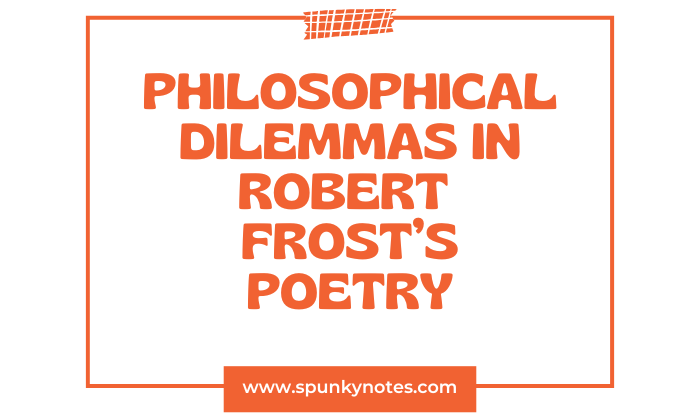
Q. How does Frost’s poetry reflect human interaction with nature and philosophical dilemmas?
Philosophical Dilemmas in Frost’s Poetry
A philosophical dilemma refers to a situation in which a person must make a difficult choice between two or more options. Each of these options has its own set of consequences.
These dilemmas often involve moral, ethical, or existential questions. Philosophical dilemmas challenge us to think critically about our values, beliefs, and the consequences of our decisions.
In Frost’s poetry, philosophical dilemmas are explored through human actions and interactions with nature. For instance, in Mending Wall, the speaker and his neighbor meet each year to repair a wall.
This wall divides their properties. One neighbor believes that “Good fences make good neighbors,” suggesting that boundaries and separations are necessary for peaceful coexistence.
However, the speaker questions whether the wall is needed at all. The natural world challenges this view.
The trees and animals do not respect boundaries. They move freely across the land. The dilemma in this poem lies in whether boundaries and divisions are necessary for human relationships or whether they limit genuine connection.
In The Oven Bird, Frost presents another philosophical dilemma. The bird’s song reflects on the passage of time and the inevitability of change. The speaker reflects on the bird’s call, realizing that life is full of transitions.
The dilemma here lies in how to respond to life’s constant changes. Should we accept them and move on? Or should we resist and try to hold onto the past? The bird’s song invites the reader to consider the meaning of time, change, and the human response to it.
Nature
Frost’s use of nature to frame these philosophical dilemmas shows how deeply interconnected human life and the natural world are. Nature is not just an external environment.
It is a reflection of the internal struggles people face. Philosophical dilemmas often arise when we are faced with questions about the nature of existence, morality, and our place in the world.
Frost uses nature to help illustrate these dilemmas, showing that our decisions are not made in isolation. They are deeply influenced by the world around us.
Human Interaction with Nature in Frost’s Poetry
Robert Frost’s poetry often presents nature as more than just a backdrop. It is a key player in the exploration of human emotions, choices, and the questions we ask about life. Nature is not simply described for its beauty.
It is used to reflect human interaction, both physical and philosophical. The landscapes Frost paints in his poems act as a mirror for human behavior and emotions. This allows readers to explore both their connection to nature and their place in the world.
For example, in The Road Not Taken, Frost uses the imagery of two diverging paths in a forest to explore the act of decision-making. The speaker of the poem stands at a crossroads.
Two roads diverged in a yellow wood,
And sorry I could not travel both
And be one traveler, long I stood
And looked down one as far as I could
To where it bent in the undergrowth;
He must choose one path over another. The paths represent the choices we face in life. The act of choosing one path over another represents the human experience of making decisions.
The speaker reflects on how this decision will shape his life. The poem suggests that while a single choice might seem small at the time, it can have a lasting impact.
Similarly, in Stopping by Woods on a Snowy Evening, the speaker is drawn to the peaceful beauty of the woods. However, he is also reminded of his responsibilities.
The woods, which are peaceful and calming, serve as a space for reflection. Yet, the speaker must leave them behind to fulfill his duties.
My little horse must think it queer
To stop without a farmhouse near
Between the woods and frozen lake
The darkest evening of the year.”But I have promises to keep,
And miles to go before I sleep,
And miles to go before I sleep.
This tension between nature’s pull and human obligations illustrates how people are constantly caught between the desire for peace and the demands of life. Nature, in this poem, acts as a space where humans reflect on their desires and responsibilities.
Philosophical Dilemmas
Another example of Frost’s exploration of philosophical dilemmas can be seen in Fire and Ice. The poem presents a choice between two destructive forces. Fire symbolizes desire, while ice symbolizes hate.
The speaker considers the destructive power of both emotions. Each of them can be destroyed if left unchecked. The dilemma here is not just about the emotions themselves. It is about which is more dangerous.
Some say the world will end in fire,
Some say in ice.
From what I’ve tasted of desire
I hold with those who favor fire.
But if it had to perish twice,
I think I know enough of hate
To say that for destruction ice
Is also great
And would suffice
Should we worry about the fiery passion of desire? Or should we worry about the cold indifference of hatred? The poem invites readers to reflect on which destructive force has the greater impact on human life.
This dilemma connects to the philosophical question about human nature and the forces that shape our actions. Frost’s use of nature in this poem—fire and ice—offers a way to think about the choices we make and their consequences.
Both desire and hate are natural emotions. However, how we deal with them can lead to different outcomes. The poem asks how we, as humans, should confront our emotions and impulses. And what consequences follow from those choices.
Death and Mortality
Frost also explores philosophical dilemmas in the context of mortality and the inevitable passage of time. In After Apple-Picking, the speaker reflects on his work of picking apples.
He wonders whether he has done enough. The apple tree represents the cycle of life—growth, harvest, and death. The philosophical dilemma in this poem is whether one can ever truly be ready for the end. The speaker’s reflections question the idea of completion and readiness.
Have we done enough with our lives? What does it mean to be finished? These are questions that many people struggle with in the face of mortality.
Nature in this poem—the apple tree and the harvest—serves as a reminder of life’s cyclical nature. But the dilemma is not just about death. It is about the uncertainty of when the end will come and whether we will be prepared for it.
This connects to questions about life’s meaning. And how we should live our lives. The poem invites readers to reflect on their own sense of fulfillment and how they come to terms over time.
Nature as a Stage for Philosophical Reflection
Nature in Frost’s poetry is often the stage where philosophical dilemmas unfold. In poems like The Road Not Taken, Mending Wall, and Fire and Ice, nature is not merely a setting.
It is a way of framing the deeper questions that humans face. Whether it is the crossroads in the woods or the icy fire that symbolizes human emotions, nature provides the perfect backdrop for these reflections.
Frost uses nature to explore how we think about our lives, our relationships with others, and our place in the world.
In Acquainted with the Night, the speaker walks alone in the dark, reflecting on his own isolation. The night represents both the physical world around him and his internal sense of loneliness.
The dilemma in this poem is how we confront our own feelings of isolation. Should we retreat into the darkness? Or should we seek out the light of connection? The night forces the speaker—and the reader—to think about how we deal with emotional struggles.
Conclusion
In conclusion, Robert Frost’s poetry reflects human interaction with nature reflecting philosophical dilemmas. Through his use of nature, Frost frames questions about life, decisions, emotions, and mortality. Nature becomes a mirror for human experiences.
It shows how we are connected to the world around us. Philosophical dilemmas, such as the choices we make, the boundaries we create, and our responses to life’s challenges, are central themes in Frost’s work.

